Method for tracking objects in a scene
a technology for tracking objects and scenes, applied in the field of scene tracking methods, can solve problems such as the problem that the model becomes too large to be solved by the standard viterbi algorithm, and achieve the effects of reducing the red eye effect of flash photography, and reducing the effect of flash photography red eye
- Summary
- Abstract
- Description
- Claims
- Application Information
AI Technical Summary
Benefits of technology
Problems solved by technology
Method used
Image
Examples
Embodiment Construction
[0043] In an embodiment of the invention, the problem of tracking multiple objects in image sequences is studied. The hidden Markov models, which traditionally is used to single object tracking, is extended to deal with multiple objects. Two such extensions are presented. One is based on extending the state space to that of multiple independently moving objects. The second extension uses multiple hidden Markov models. The theory has been tested on a parking lot occupancy monitoring with promising results.
[0044] Referring to FIG. 1, an overview of a method for tracking objects in a scene will be described. The scene is monitored by a digital camera for obtaining a sequence of digital images of the scene, step 1. First, a region of interest in the digital images is separated into a plurality of spatially smaller, overlapping modules, step 2. A hidden Markov model is defined for each module, step 3. The hidden Markov model has a state space describing a grid of centre points of object...
PUM
 Login to View More
Login to View More Abstract
Description
Claims
Application Information
 Login to View More
Login to View More - R&D
- Intellectual Property
- Life Sciences
- Materials
- Tech Scout
- Unparalleled Data Quality
- Higher Quality Content
- 60% Fewer Hallucinations
Browse by: Latest US Patents, China's latest patents, Technical Efficacy Thesaurus, Application Domain, Technology Topic, Popular Technical Reports.
© 2025 PatSnap. All rights reserved.Legal|Privacy policy|Modern Slavery Act Transparency Statement|Sitemap|About US| Contact US: help@patsnap.com



